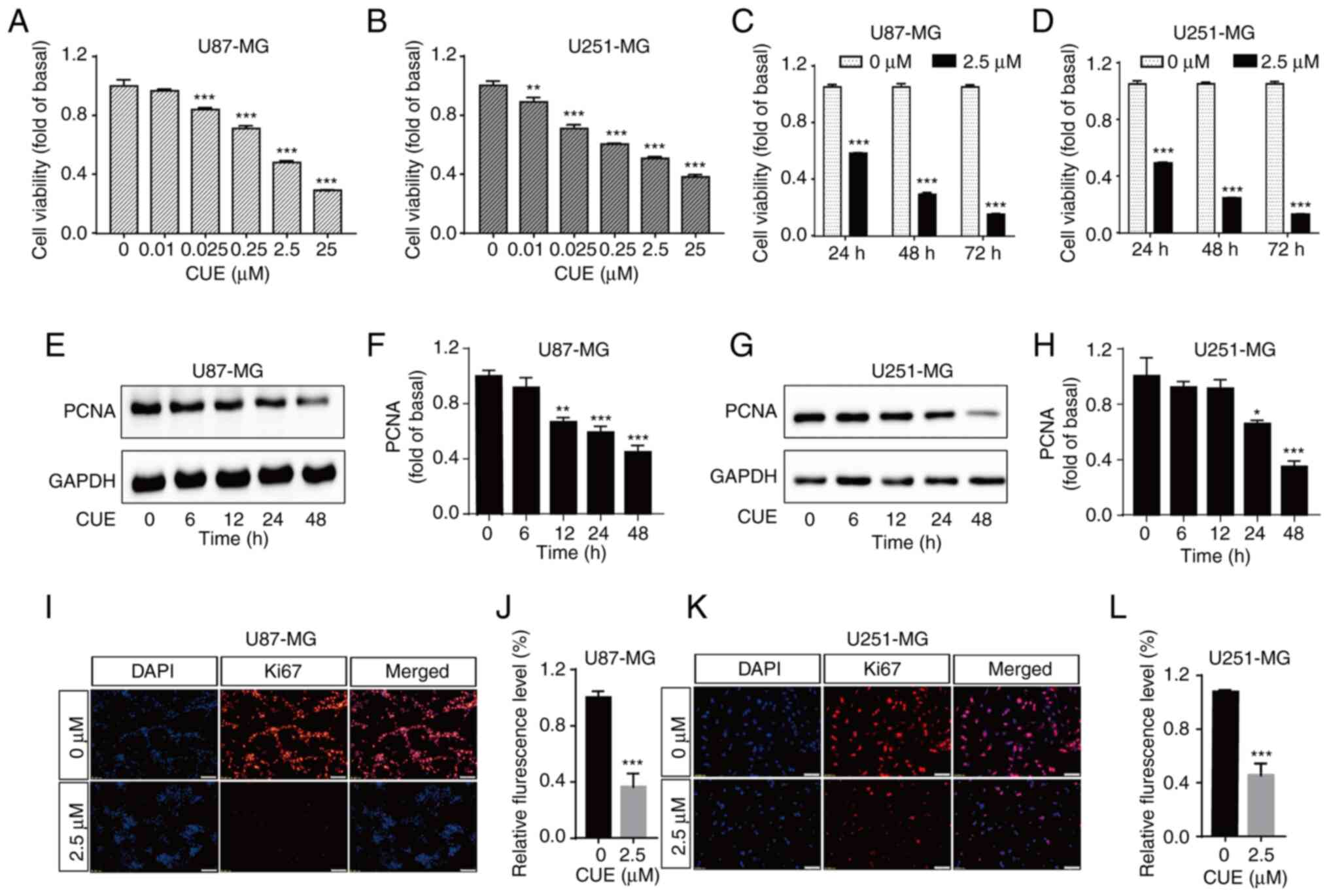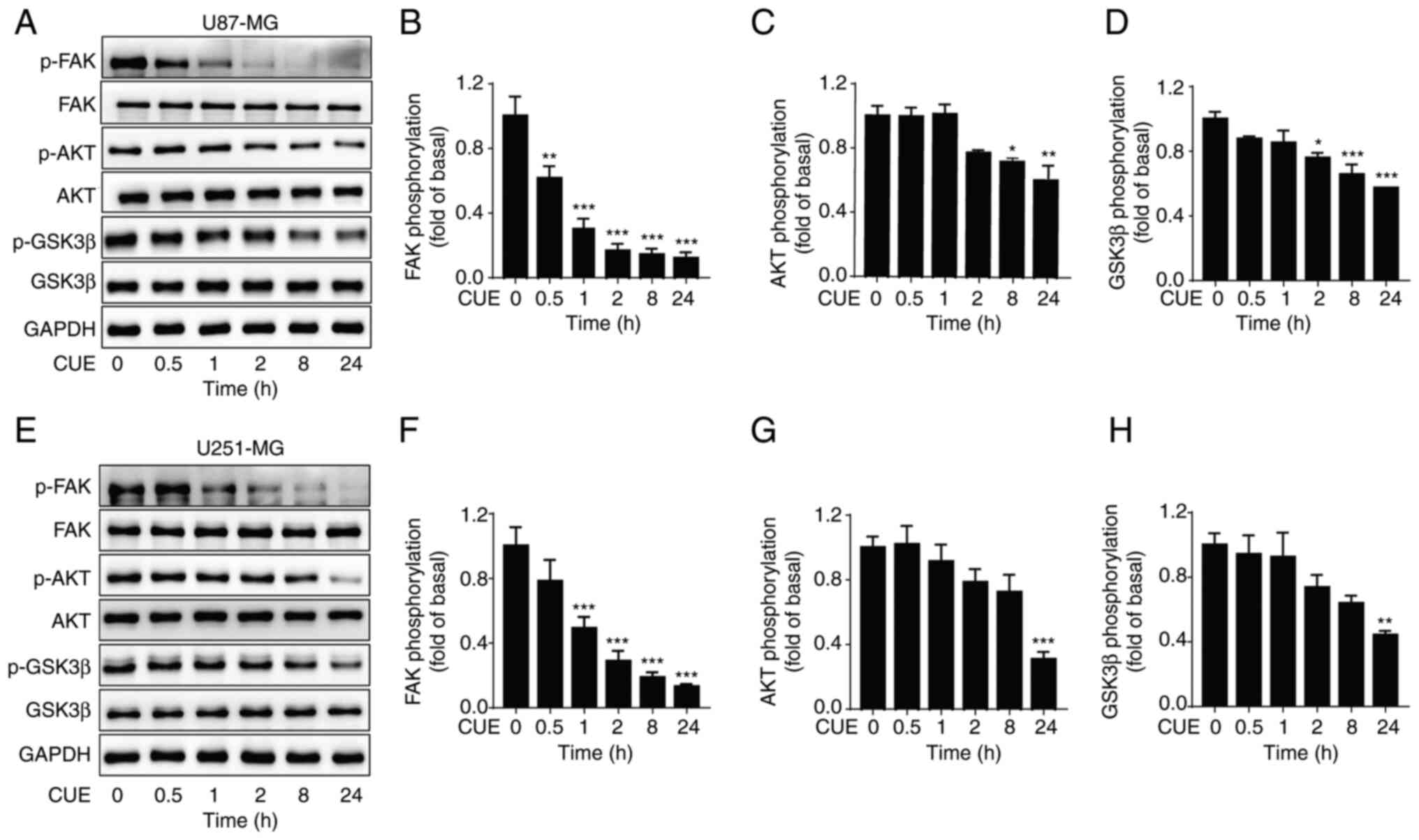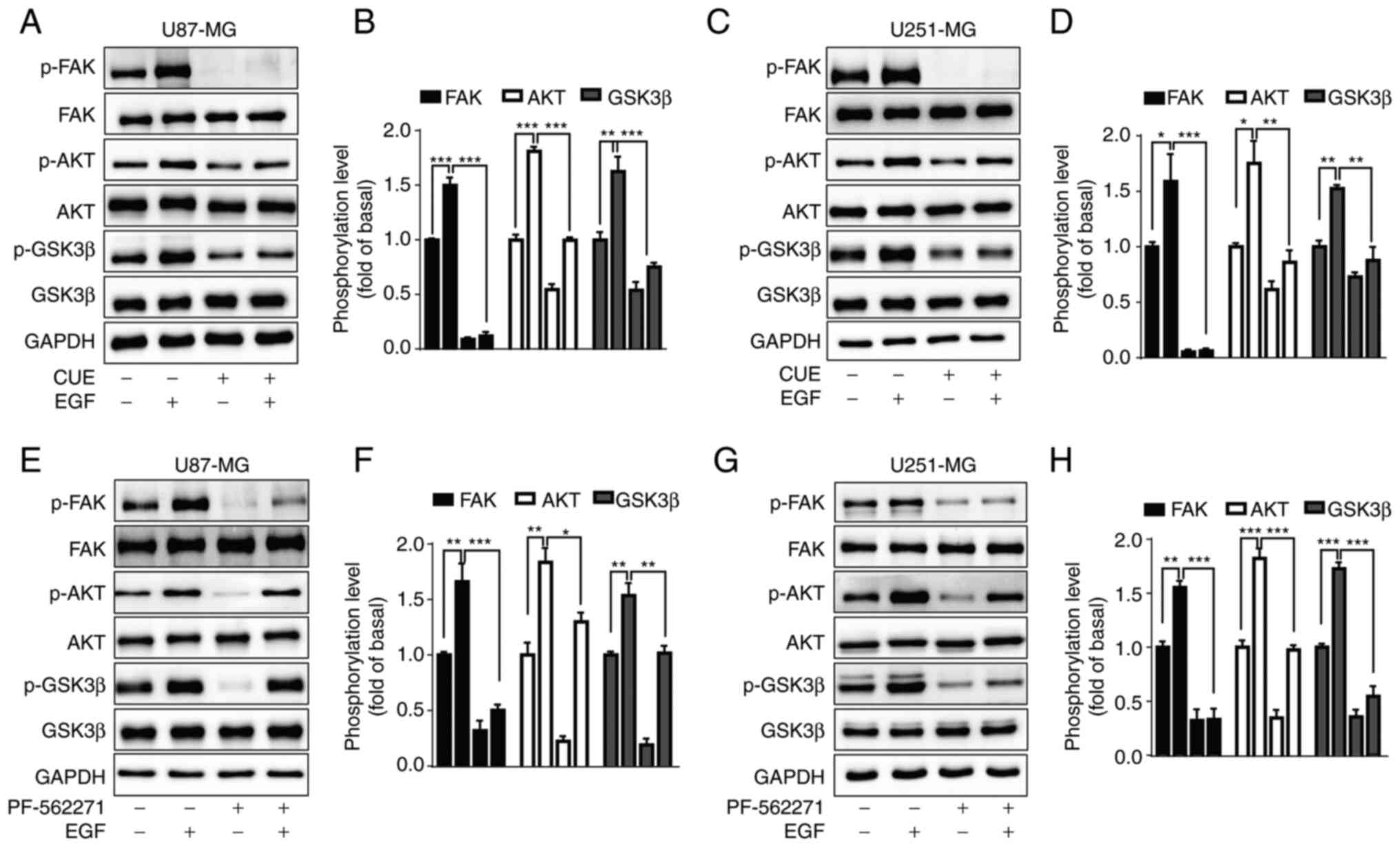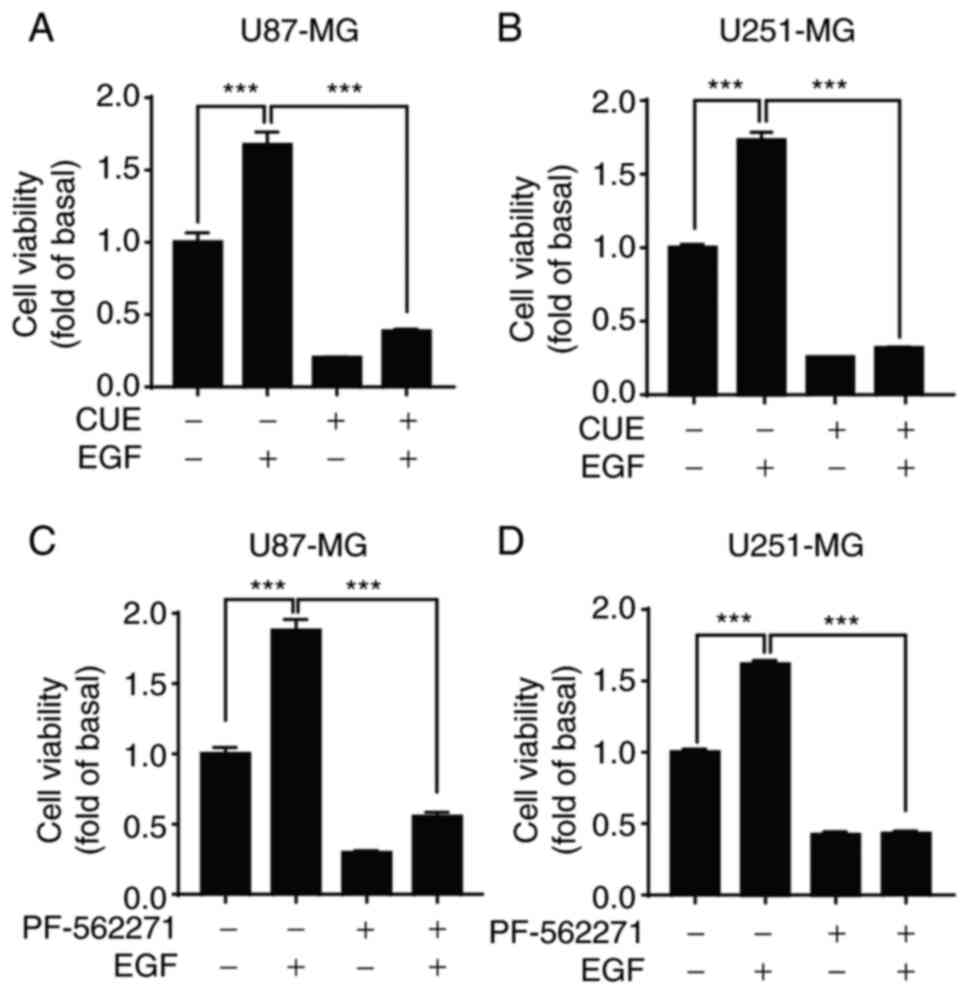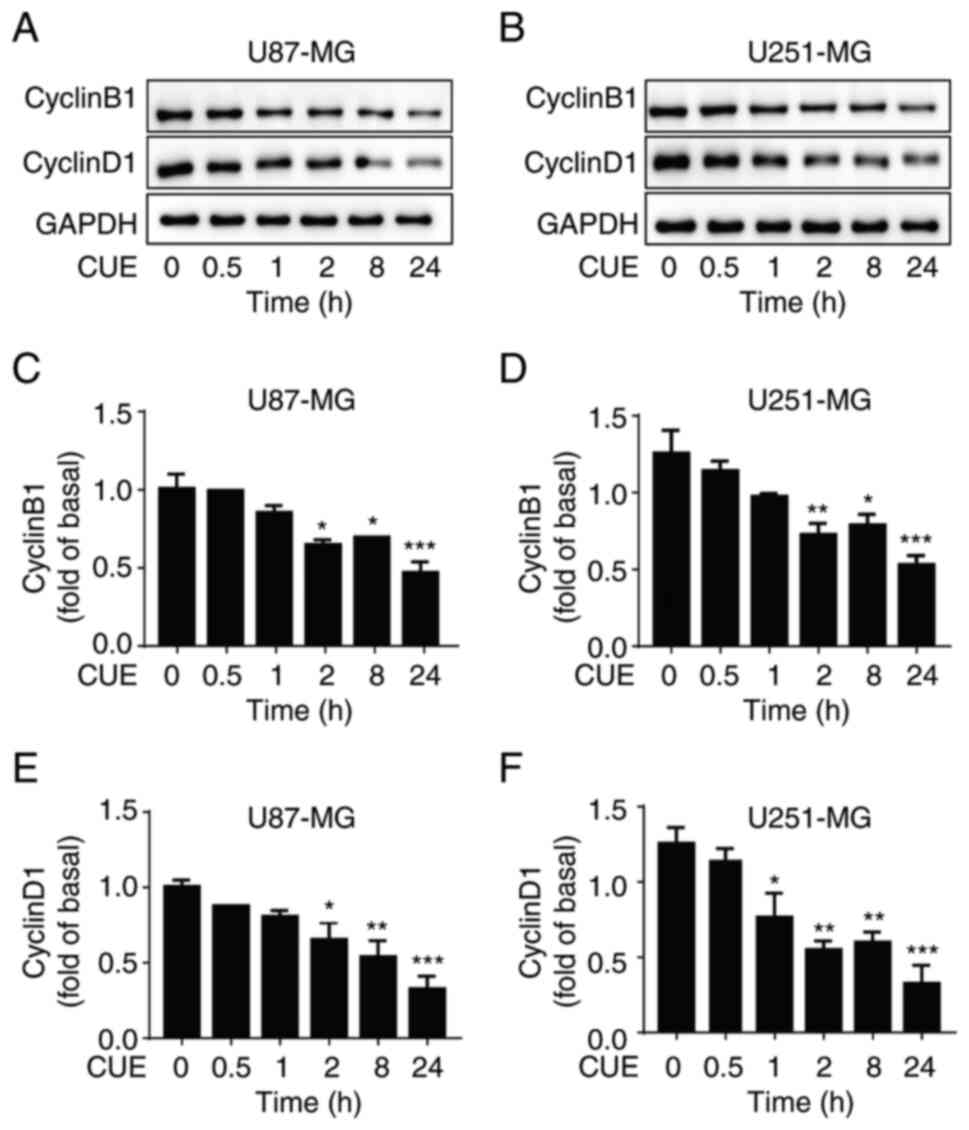|
1
|
Perus LJM and Walsh LA: Microenvironmental
heterogeneity in brain malignancies. Front Immunol. 10:22942019.
View Article : Google Scholar : PubMed/NCBI
|
|
2
|
Goenka A, Tiek D, Song X, Huang T, Hu B
and Cheng SY: The many facets of therapy resistance and tumor
recurrence in glioblastoma. Cells. 10:4842021. View Article : Google Scholar : PubMed/NCBI
|
|
3
|
Guo G, Sun Y, Hong R, Xiong J, Lu Y, Liu
Y, Lu J, Zhang Z, Guo C, Nan Y and Huang Q: IKBKE enhances
TMZ-chemoresistance through upregulation of MGMT expression in
glioblastoma. Clin Transl Oncol. 22:1252–1262. 2020. View Article : Google Scholar : PubMed/NCBI
|
|
4
|
Jackson CM, Choi J and Lim M: Mechanisms
of immunotherapy resistance: Lessons from glioblastoma. Nat
Immunol. 20:1100–1109. 2019. View Article : Google Scholar : PubMed/NCBI
|
|
5
|
Rong L, Li N and Zhang Z: Emerging
therapies for glioblastoma: Current state and future directions. J
Exp Clin Cancer Res. 41:1422022. View Article : Google Scholar : PubMed/NCBI
|
|
6
|
Alghasham AA: Cucurbitacins-a promising
target for cancer therapy. Int J Health Sci (Qassim). 7:77–89.
2013.PubMed/NCBI
|
|
7
|
Si W, Lyu J, Liu Z, Wang C, Huang J, Jiang
L and Ma T: Cucurbitacin E inhibits cellular proliferation and
enhances the chemo-response in gastric cancer by suppressing AKt
activation. J Cancer. 10:5843–5851. 2019. View Article : Google Scholar : PubMed/NCBI
|
|
8
|
Feng H, Zang L, Zhao ZX and Kan QC:
Cucurbitacin-E inhibits multiple cancer cells proliferation through
attenuation of Wnt/β-catenin signaling. Cancer Biother Radiopharm.
29:210–214. 2014.PubMed/NCBI
|
|
9
|
He X, Gao Q, Qiang Y, Guo W and Ma Y:
Cucurbitacin E induces apoptosis of human prostate cancer cells via
cofilin-1 and mTORC1. Oncol Lett. 13:4905–4910. 2017. View Article : Google Scholar : PubMed/NCBI
|
|
10
|
Kong Y, Chen J, Zhou Z, Xia H, Qiu MH and
Chen C: Cucurbitacin E induces cell cycle G2/M phase arrest and
apoptosis in triple negative breast cancer. PLoS One.
9:e1037602014. View Article : Google Scholar : PubMed/NCBI
|
|
11
|
Duncan KL, Duncan MD, Alley MC and
Sausville EA: Cucurbitacin E-induced disruption of the actin and
vimentin cytoskeleton in prostate carcinoma cells. Biochem
Pharmacol. 52:1553–1560. 1996. View Article : Google Scholar : PubMed/NCBI
|
|
12
|
Momma K, Masuzawa Y, Nakai N, Chujo M,
Murakami A, Kioka N, Kiyama Y, Akita T and Nagao M: Direct
interaction of cucurbitacin E isolated from Alsomitra macrocarpa to
actin filament. Cytotechnology. 56:33–39. 2008. View Article : Google Scholar : PubMed/NCBI
|
|
13
|
Dong Y, Lu B, Zhang X, Zhang J, Lai L, Li
D, Wu Y, Song Y, Luo J, Pang X, et al: Cucurbitacin E, a
tetracyclic triterpenes compound from Chinese medicine, inhibits
tumor angiogenesis through VEGFR2-mediated Jak2-STAT3 signaling
pathway. Carcinogenesis. 31:2097–2104. 2010. View Article : Google Scholar : PubMed/NCBI
|
|
14
|
Hsu PC, Tian B, Yang YL, Wang YC, Liu S,
Urisman A, Yang CT, Xu Z, Jablons DM and You L: Cucurbitacin E
inhibits the Yes-associated protein signaling pathway and
suppresses brain metastasis of human non-small cell lung cancer in
a murine model. Oncol Rep. 42:697–707. 2019.PubMed/NCBI
|
|
15
|
Wang Y, Xu S, Wu Y and Zhang J:
Cucurbitacin E inhibits osteosarcoma cells proliferation and
invasion through attenuation of PI3K/AKT/mTOR signalling pathway.
Biosci Rep. 36:e004052016. View Article : Google Scholar : PubMed/NCBI
|
|
16
|
Yang P, Lian Q, Fu R, Ding GB, Amin S and
Li Z and Li Z: Cucurbitacin E triggers cellular senescence in colon
cancer cells via regulating the miR-371b-5p/TFAP4 signaling
pathway. J Agric Food Chem. 70:2936–2947. 2022. View Article : Google Scholar : PubMed/NCBI
|
|
17
|
Hsu YC, Chen MJ and Huang TY: Inducement
of mitosis delay by cucurbitacin E, a novel tetracyclic triterpene
from climbing stem of Cucumis melo L., through GADD45γ in
human brain malignant glioma (GBM) 8401 cells. Cell Death Dis.
5:e10872014. View Article : Google Scholar : PubMed/NCBI
|
|
18
|
Cheng AC, Hsu YC and Tsai CC: The effects
of cucurbitacin E on GADD45β-trigger G2/M arrest and
JNK-independent pathway in brain cancer cells. J Cell Mol Med.
23:3512–3519. 2019. View Article : Google Scholar : PubMed/NCBI
|
|
19
|
Lemmon MA and Schlessinger J: Cell
signaling by receptor tyrosine kinases. Cell. 141:1117–1134. 2010.
View Article : Google Scholar : PubMed/NCBI
|
|
20
|
Sigismund S, Avanzato D and Lanzetti L:
Emerging functions of the EGFR in cancer. Mol Oncol. 12:3–20. 2018.
View Article : Google Scholar : PubMed/NCBI
|
|
21
|
Rajaram P, Chandra P, Ticku S, Pallavi BK,
Rudresh KB and Mansabdar P: Epidermal growth factor receptor: Role
in human cancer. Indian J Dent Res. 28:687–694. 2017. View Article : Google Scholar : PubMed/NCBI
|
|
22
|
Lui VW, Thomas SM, Zhang Q, Wentzel AL,
Siegfried JM, Li JY and Grandis JR: Mitogenic effects of
gastrin-releasing peptide in head and neck squamous cancer cells
are mediated by activation of the epidermal growth factor receptor.
Oncogene. 22:6183–6193. 2003. View Article : Google Scholar : PubMed/NCBI
|
|
23
|
Mishra R, Hanker AB and Garrett JT:
Genomic alterations of ERBB receptors in cancer: Clinical
implications. Oncotarget. 8:114371–114392. 2017. View Article : Google Scholar : PubMed/NCBI
|
|
24
|
Mitra SK, Mikolon D, Molina JE, Hsia DA,
Hanson DA, Chi A, Lim ST, Bernard-Trifilo JA, Ilic D, Stupack DG,
et al: Intrinsic FAK activity and Y925 phosphorylation facilitate
an angiogenic switch in tumors. Oncogene. 25:5969–5984. 2006.
View Article : Google Scholar : PubMed/NCBI
|
|
25
|
Ilić D, Furuta Y, Kanazawa S, Takeda N,
Sobue K, Nakatsuji N, Nomura S, Fujimoto J, Okada M and Yamamoto T:
Reduced cell motility and enhanced focal adhesion contact formation
in cells from FAK-deficient mice. Nature. 377:539–544. 1995.
View Article : Google Scholar : PubMed/NCBI
|
|
26
|
Golubovskaya V, Beviglia L, Xu LH, Earp HS
III, Craven R and Cance W: Dual inhibition of focal adhesion kinase
and epidermal growth factor receptor pathways cooperatively induces
death receptor-mediated apoptosis in human breast cancer cells. J
Biol Chem. 277:38978–38987. 2002. View Article : Google Scholar : PubMed/NCBI
|
|
27
|
Revathidevi S and Munirajan AK: Akt in
cancer: Mediator and more. Semin Cancer Biol. 59:80–91. 2019.
View Article : Google Scholar : PubMed/NCBI
|
|
28
|
Xie Y, Du J, Liu Z, Zhang D, Yao X and
Yang Y: MiR-6875-3p promotes the proliferation, invasion and
metastasis of hepatocellular carcinoma via BTG2/FAK/Akt pathway. J
Exp Clin Cancer Res. 38:72019. View Article : Google Scholar : PubMed/NCBI
|
|
29
|
Chen X, Guo ZQ, Cao D, Chen Y and Chen J:
MYC-mediated upregulation of PNO1 promotes glioma tumorigenesis by
activating THBS1/FAK/Akt signaling. Cell Death Dis. 12:2442021.
View Article : Google Scholar : PubMed/NCBI
|
|
30
|
Fan Z, Xu Q, Wang C, Lin X, Zhang Q and Wu
N: A tropomyosin-like meretrix meretrix linnaeus polypeptide
inhibits the proliferation and metastasis of glioma cells via
microtubule polymerization and FAK/Akt/MMPs signaling. Int J Biol
Macromol. 145:154–164. 2020. View Article : Google Scholar : PubMed/NCBI
|
|
31
|
Wang JF, Chen YY, Zhang SW, Zhao K, Qiu Y,
Wang Y, Wang JC, Yu Z, Li BP, Wang Z and Chen JQ: ITGA5 promotes
tumor progression through the activation of the FAK/AKT signaling
pathway in human gastric cancer. Oxid Med Cell Longev.
2022:86113062022.PubMed/NCBI
|
|
32
|
Benelli R, Monteghirfo S, Venè R, Tosetti
F and Ferrari N: The chemopreventive retinoid 4HPR impairs prostate
cancer cell migration and invasion by interfering with
FAK/AKT/GSK3beta pathway and beta-catenin stability. Mol Cancer.
9:1422010. View Article : Google Scholar : PubMed/NCBI
|
|
33
|
Xie X, Lin W, Zheng W, Chen T, Yang H, Sun
L, Huang F, Wang Z, Lin H, Chen L, et al: Downregulation of
G2/mitotic-specific cyclinB1 triggers autophagy via
AMPK-ULK1-dependent signal pathway in nasopharyngeal carcinoma
cells. Cell Death Dis. 10:942019. View Article : Google Scholar : PubMed/NCBI
|
|
34
|
Yuan J, Yan R, Krämer A, Eckerdt F, Roller
M, Kaufmann M and Strebhardt K: Cyclin B1 depletion inhibits
proliferation and induces apoptosis in human tumor cells. Oncogene.
23:5843–5852. 2004. View Article : Google Scholar : PubMed/NCBI
|
|
35
|
Qi Y, Wang D, Huang W, Wang B, Huang D,
Xiong F, Chen X and Chen Y: CyclinD1 inhibits dicer and crucial
miRNA expression by chromatin modification to promote the
progression of intrahepatic cholangiocarcinoma. J Exp Clin Cancer
Res. 38:4132019. View Article : Google Scholar : PubMed/NCBI
|
|
36
|
Bian ZQ, Luo Y, Guo F, Huang YZ, Zhong M
and Cao H: Overexpressed ACP5 has prognostic value in colorectal
cancer and promotes cell proliferation and tumorigenesis via
FAK/PI3K/AKT signaling pathway. Am J Cancer Res. 9:22–35.
2019.PubMed/NCBI
|
|
37
|
Zhang B, Ma X, Li Y, Li S and Cheng J:
Pleuromutilin inhibits proliferation and migration of A2780 and
Caov-3 ovarian carcinoma cells and growth of mouse A2780 tumor
xenografts by down-regulation of pFAK2. Med Sci Monit.
26:e9204072020.PubMed/NCBI
|
|
38
|
Nuñez RE, del Valle MM, Ortiz K, Almodovar
L and Kucheryavykh L: Microglial cytokines induce invasiveness and
proliferation of human glioblastoma through Pyk2 and FAK
activation. Cancers (Basel). 13:61602021. View Article : Google Scholar : PubMed/NCBI
|
|
39
|
Toyama M, Hamaoka Y and Katoh H: EphA3 is
up-regulated by epidermal growth factor and promotes formation of
glioblastoma cell aggregates. Biochem Biophys Res Commun.
508:715–721. 2019. View Article : Google Scholar : PubMed/NCBI
|
|
40
|
Zou Q, Hou Y, Shen F and Wang Y: Polarized
regulation of glycogen synthase kinase-3β is important for glioma
cell invasion. PLoS One. 8:e818142013. View Article : Google Scholar : PubMed/NCBI
|
|
41
|
Zhang T, Li J, Dong Y, Zhai D, Lai L, Dai
F, Deng H, Chen Y, Liu M and Yi Z: Cucurbitacin E inhibits breast
tumor metastasis by suppressing cell migration and invasion. Breast
Cancer Res Treat. 135:445–458. 2012. View Article : Google Scholar : PubMed/NCBI
|
|
42
|
Zha QB, Zhang XY, Lin QR, Xu LH, Zhao GX,
Pan H, Zhou D, Ouyang DY, Liu ZH and He XH: Cucurbitacin E induces
autophagy via downregulating mTORC1 signaling and upregulating AMPK
activity. PLoS One. 10:e01243552015. View Article : Google Scholar : PubMed/NCBI
|
|
43
|
Wu YL, Zhang YJ, Yao YL, Li ZM, Han X,
Lian LH, Zhao YQ and Nan JX: Cucurbitacin E ameliorates hepatic
fibrosis in vivo and in vitro through activation of AMPK and
blocking mTOR-dependent signaling pathway. Toxicol Lett.
258:147–158. 2016. View Article : Google Scholar : PubMed/NCBI
|
|
44
|
Jia Q, Cheng W, Yue Y, Hu Y, Zhang J, Pan
X, Xu Z and Zhang P: Cucurbitacin E inhibits TNF-α-induced
inflammatory cytokine production in human synoviocyte MH7A cells
via suppression of PI3K/Akt/NF-κB pathways. Int Immunopharmacol.
29:884–890. 2015. View Article : Google Scholar : PubMed/NCBI
|
|
45
|
Juríková M, Danihel Ľ, Polák Š and Varga
I: Ki67, PCNA, and MCM proteins: Markers of proliferation in the
diagnosis of breast cancer. Acta Histochem. 118:544–552. 2016.
View Article : Google Scholar : PubMed/NCBI
|
|
46
|
Zhang J and Hochwald SN: The role of FAK
in tumor metabolism and therapy. Pharmacol Ther. 142:154–163. 2014.
View Article : Google Scholar : PubMed/NCBI
|
|
47
|
Sulzmaier FJ, Jean C and Schlaepfer DD:
FAK in cancer: Mechanistic findings and clinical applications. Nat
Rev Cancer. 14:598–610. 2014. View Article : Google Scholar : PubMed/NCBI
|
|
48
|
Yoon H, Dehart JP, Murphy JM and Lim STS:
Understanding the roles of FAK in cancer: Inhibitors, genetic
models, and new insights. J Histochem Cytochem. 63:114–128. 2015.
View Article : Google Scholar : PubMed/NCBI
|
|
49
|
Sharma AK, Kline CL, Berg A, Amin S and
Irby RB: The Akt inhibitor ISC-4 activates prostate apoptosis
response protein-4 and reduces colon tumor growth in a nude mouse
model. Clin Cancer Res. 17:4474–4483. 2011. View Article : Google Scholar : PubMed/NCBI
|
|
50
|
Gao F, Huang W, Zhang Y, Tang S, Zheng L,
Ma F, Wang Y, Tang H and Li X: Hes1 promotes cell proliferation and
migration by activating Bmi-1 and PTEN/Akt/GSK3β pathway in human
colon cancer. Oncotarget. 6:38667–38680. 2015. View Article : Google Scholar : PubMed/NCBI
|
|
51
|
Liu X, Wang P, Zhang C and Ma Z: Epidermal
growth factor receptor (EGFR): A rising star in the era of
precision medicine of lung cancer. Oncotarget. 8:50209–50220. 2017.
View Article : Google Scholar : PubMed/NCBI
|
|
52
|
Yarden Y: The EGFR family and its ligands
in human cancer. Signalling mechanisms and therapeutic
opportunities. Eur J Cancer. 37 (Suppl 4):S3–S8. 2001. View Article : Google Scholar : PubMed/NCBI
|
|
53
|
Laurent-Puig P, Lievre A and Blons H:
Mutations and response to epidermal growth factor receptor
inhibitors. Clin Cancer Res. 15:1133–1139. 2009. View Article : Google Scholar : PubMed/NCBI
|
|
54
|
Long W, Yi P, Amazit L, LaMarca HL,
Ashcroft F, Kumar R, Mancini MA, Tsai SY, Tsai MJ and O'Malley BW:
SRC-3Delta4 mediates the interaction of EGFR with FAK to promote
cell migration. Mol Cell. 37:321–332. 2010. View Article : Google Scholar : PubMed/NCBI
|
|
55
|
Li M, Zheng W and Wang C: CyclinD1
promotes lymph node metastasis by inducing lymphangiogenesis in
human ovarian carcinoma. Int J Clin Exp Pathol. 11:3726–3731.
2018.PubMed/NCBI
|
|
56
|
Tang Y, Xie M, Jiang N, Huang F, Zhang X,
Li R, Lu J, Liao S and Liu Y: Icarisid II inhibits the
proliferation of human osteosarcoma cells by inducing apoptosis and
cell cycle arrest. Tumour Biol. 39:10104283177057452017. View Article : Google Scholar : PubMed/NCBI
|
|
57
|
Wei Y, Huang C, Wu H and Huang J: Estrogen
receptor beta (ERβ) mediated-cyclinD1 degradation via autophagy
plays an anti-proliferation role in colon cells. Int J Biol Sci.
15:942–952. 2019. View Article : Google Scholar : PubMed/NCBI
|
|
58
|
Rattanaburee T, Tipmanee V, Tedasen A,
Thongpanchang T and Graidist P: Inhibition of CSF1R and AKT by
(±)-kusunokinin hinders breast cancer cell proliferation. Biomed
Pharmacother. 129:1103612020. View Article : Google Scholar : PubMed/NCBI
|
|
59
|
Hu Y, Cheng Y, Jiang X, Zhang Y, Wang H,
Ren H, Xu Y, Jiang J, Wang Q, Su H, et al: PCGF3 promotes the
proliferation and migration of non-small cell lung cancer cells via
the PI3K/AKT signaling pathway. Exp Cell Res. 400:1124962021.
View Article : Google Scholar : PubMed/NCBI
|



